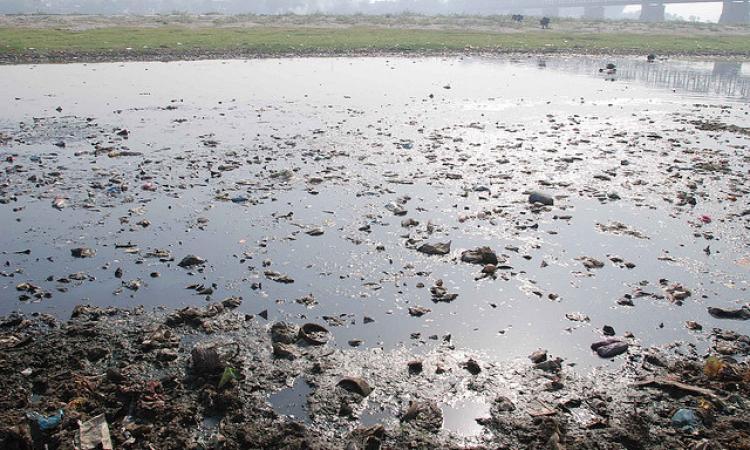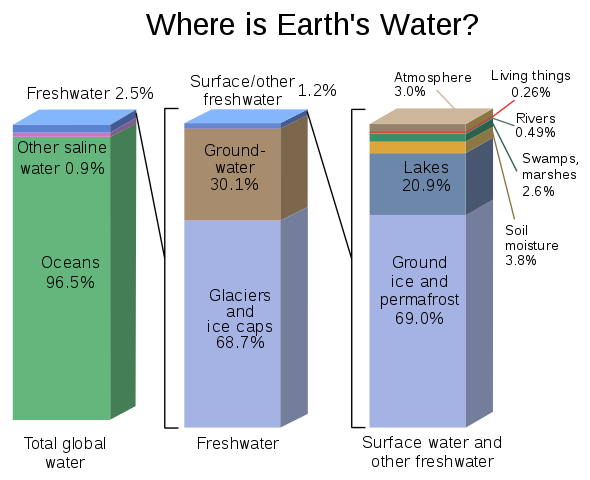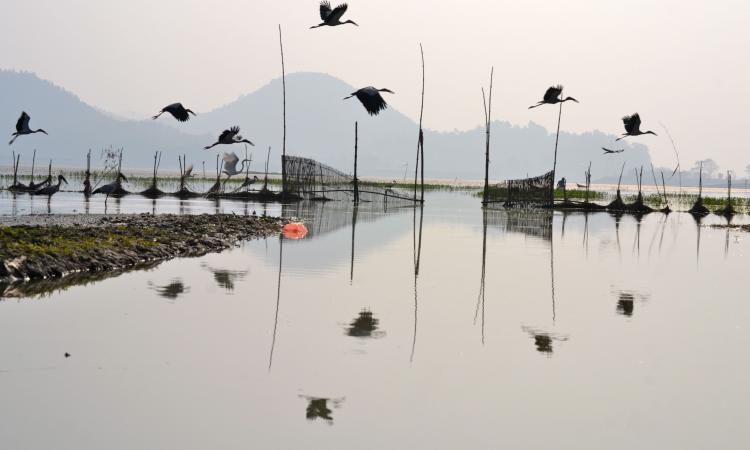
Where is water on earth located?
Water on earth exists in two forms, freshwater and salt water. Less than 3 percent of the water found on earth is freshwater, and the remaining 97 percent is salt water found in the oceans.

Freshwater is rare and extremely important for survival of humans and a range of animals inhabiting the waters. Most of the freshwater is not easily accessible with 69 percent being available in frozen form as ice in glaciers and polar ice caps and 30 percent being present under the surface in the form of groundwater.
Only about 1 percent of earth’s freshwater is readily available for human use and found in surface water sources such as rivers, lakes, ponds and streams.
Freshwater exists in India in the form of surface water sources such as wetlands, lakes, rivers, ponds, streams, springs, cave waters, floodplains, bogs, marshes, swamps and groundwater. Freshwater habitats in India are extremely biodiverse and about 9.7 percent of the total Indian fauna (animals, small and large) are found to live in or near freshwater ecosystems.
However, freshwater resources are deteriorating rapidly due to increasing pollution and contamination and disappearing at an alarming rate due to human interventions.
What are the types of freshwater sources available for human use?
Freshwater is crucial for agriculture and food production, is vital for survival of humans in the form of drinking water, and necessary for industrial use as well as for recreation. The sources of freshwater commonly used include groundwater accessed from dugwells and tubewells and water accessed from surface water sources such as rivers, lakes, ponds and streams. While rivers account for only a small amount of freshwater, they are the most important source of freshwater for human civilisations since times immemorial.
But then this water may not be safe to drink and for survival of ecosystems. It can get polluted and contaminated.
What is water contamination? How is it different from pollution?
Chapman (2007) defines contamination as the presence of a substance where it should not be or at concentrations above normal levels while pollution is contamination that can result in adverse biological effects on humans and plants and animals that depend on this water for their survival. All pollutants are contaminants, but not all contaminants are pollutants.
- Pollution is mainly caused due to human activities, whereas contamination can be human induced or occur naturally in the environment.
- The extent of damage is usually higher in pollution compared to contamination because pollutants can disturb the balance of the ecosystem on a broader scale compared to contaminants.
- Pollution usually impacts the larger environment, while contamination may occur on a limited scale or within a particular substance or body and can be easily mitigated.
There are two categories of water pollution. 'Point source' pollution - occurs when harmful substances enter directly into the water from a source while 'non point source' pollution- occurs when pollutants enter indirectly through transport or environment.
How do surface water sources get polluted?
Lakes, oceans, streams, rivers, ponds, reservoirs, and wetlands - surface water sources are responsible for providing potable drinking water to majority of the populations. Surface water is extremely susceptible to pollution due to release of harmful fertiliser and pesticide residues, effluents from industries due to human activities such as agriculture, industrialisation and release of untreated sewage generated in urban areas into water bodies such as rivers and lakes.
- Point source pollution can happen from an identifiable source like a factory or sewage treatment plant and discharged through a pipeline, ditch, or any other means that directly or indirectly enters a body of water.
- Non-point source pollution is not easily identifiable. Agricultural and stormwater runoff are the common types of nonpoint source pollutants that can carry harmful chemicals and substances into the water. However, it can be difficult to trace the original source of the pollution. It can be expensive and very difficult to remove a contaminant once it has entered surface water.
Surface water sources are highly contaminated in India. Poor sewage disposal mechanisms lead to most of the untreated sewage being drained into rivers and lakes that serve as reservoirs of microbial contamination. Poor access to safe water sources and toilets and open defecation and poor WASH practices lead to high instances of waterborne diseases in the country. Release of untreated industrial and pharmaceutical wastes into the surface water sources has led to dangerous levels of organic and inorganic pollutants into the surface water bodies in India, making it unfit for consumption.
How do groundwater resources get polluted?
Groundwater pollution happens due to release of pollutants into the underlying aquifers (naturally occurring underground water bearing layers of rocks that serve as reservoirs of water and transmit water to wells and springs). Once the pollutants are released either intentionally or accidently through anthropogenic activities or natural causes into groundwater, they can contaminate groundwater.
The pollutants move within aquifers depending on their biological, physical, and chemical properties through processes such as diffusion, dispersion, adsorption, and the speed of moving water often helps in spreading this contamination. However, the movement of the contaminants within an aquifer is usually slow and their concentration tends to be high and in a form called a plume. As the plume spreads it can also connect with springs and ground wells making them unsafe for human consumption.

Groundwater pollution can occur due to naturally occurring substances found in the soil and rocks, improperly designed and leaking septic systems that release contaminants such as nitrates, oils, bacteria, chemicals, detergents, and viruses into underground water, poor waste management systems, untreated sewage, effluents from industries and runoff from fertilisers and pesticides used in agriculture.
Groundwater resources in India are highly polluted due to presence of fluoride, arsenic, nitrates, iron, heavy metals as well as due to leaching of harmful pesticide and fertiliser residues. Toxins from untreated industrial wastes and landfills as well as bacterial contaminants from the surface soil and water sources can also contaminate groundwater.
What are the types of contamination?
Water sources can get polluted because of a range of harmful contaminants. The common contaminants occurring in drinking water can be classified into:
- Inorganic contaminants: include metals such as fluoride, arsenic, lead, copper, chromium, mercury, antimony, cyanide that can get into drinking water (surface as well as groundwater) from natural sources, industrial processes, as well as from plumbing systems.
- Organic contaminants include pesticides, untreated domestic and industrial wastes etc that can get into rivers, lakes, ponds and even groundwater. Contamination through organic materials can cause serious health problems like cancers, hormonal disruptions, and nervous system disorders.
- Biological contaminants include the presence of living organisms, such as algae, bacteria, protozoa or viruses in the water. Each of these can lead to a range of health problems among humans.
- Radiological contaminants include radioactive materials that are found naturally in the soil or rocks or generated through industrial wastes that can get mixed with drinking water (surface water as well as groundwater) at the source.
Know more on conventional and emerging contaminants in drinking water here
What are the health impacts of contaminated drinking water?
Inorganic pollutants in water can be extremely harmful and lead to a range of chronic and fatal health problems ranging from poisoning to organ damage and cancers. For example, high levels of arsenic, lead, asbestos, cyanide, copper etc in water can be extremely harmful to health and can lead to problems like dental and skeletal fluorosis in case of excessive levels of fluoride, arsenicosis due to high levels of arsenic and endocrine disruptions and neurological damage due to presence of excessive amounts of mercury.
Organic and radiological contaminants can also lead to a range of dangerous health impacts on the body such as cancers, liver and kidney damage, reproductive and endocrine disorders, birth defects etc.
Read more on organic, inorganic and radiological contaminants of drinking water and their health effects here.
The WHO factsheets on individual chemical contaminants of drinking water and their health impacts can be accessed here
The WHO factsheets on individual microbial contaminants of drinking water and their health impacts here
Biological contamination of water due to viruses, bacteria and protozoa can lead to a range of waterborne diseases such as diarrhoea, dysentry, cholera, typhoid, hepatitis that can prove fatal if not treated in time.
What are the health impacts of contaminated drinking water in India?
Waterborne diseases are rampant in India due to high levels of biological contamination of water. Annually about 37.7 million Indians are affected by waterborne diseases, 1.5 million children die of diarrhoea and 73 million working days are lost leading to an economic burden of $600 million a year.
Waterborne diseases such as cholera, acute diarrhoeal diseases, typhoid and viral hepatitis have caused 10,738 deaths, over the last five years since 2017. Of this, acute diarrhoeal diseases have caused maximum deaths followed by viral hepatitis, typhoid and cholera.
Read frequently asked questions on water borne diseases here
Read more on how water contamination in India has led to increased bacterial resistance and the emergence of superbugs, a grave health hazard here.
Water (sourced from groundwater) contamination due to fluoride, arsenic, iron, manganese, uranium and radon is high in selected states in India. Central Groundwater Board (2014) data reveals that as high as 66 million people are drinking water with fluoride levels beyond permissible limits in India leading to dental and skeletal fluorosis. Contamination of drinking water with arsenic is rampant in the states of West Bengal and Bihar besides Uttar Pradesh, Madhya Pradesh and Karnataka leading to arsenic poisoning and cancers.
Studies by the Central Water Commission (2015) also show that rivers (surface drinking water sources) in India are loaded with heavy metals such as lead, arsenic, copper, cadmium, mercury and nickel that are highly toxic and carcinogenic way beyond standards prescribed by Indian Council of Medical Research (ICMR) and Bureau of Indian Standards (BIS).
Read more about fluorosis in India here. Read more on arsenic contamination of drinking water in India here.
Read more about micropollutants found in groundwater in India and their health impacts here.
What are the impacts of water contamination and pollution on biodiversity?
Water contamination not only affects human health, but also has a severely negative impact on freshwater biodiversity. Besides its usefulness for humans, freshwater is crucial for the survival of numerous animals that inhabit and depend on it for their survival.

Read this report by Food and Agricultural Organisation (FAO) on freshwater ecosystems and animals inhabiting them here
Read this recent report on freshwater fish titled 'World's forgotten fishes' by World Wildlife Fund (WWF) here
Read this recently published report on the 'Faunal diversity of Ramsar wetlands in India' published by Zoological Survey of India and Ministry of Environment and Forests here
Freshwater biodiversity is a source of vital ecosystem services such as food, building material, prevention of floods and erosion and contributes to economic productivity and is a treasure trove of genetic material.
Water pollution severely damages aquatic ecosystems. Rivers and lakes often become open sewers for industrial and residential waste. Pesticides, herbicides, oil products, heavy metals such as mercury, lead, and zinc, detergents, and industrial wastes can kill aquatic organisms by changing the environment making it extremely difficult for aquatic animals (small and large) to survive.
Toxic wastes in aquatic environments diffuse over a wide area. Many aquatic environments are naturally low in essential minerals, such as nitrates and phosphates, and aquatic species have adapted to the natural scarcity of minerals by developing the ability to process large volumes of water and to concentrate these minerals. When these species process polluted water, they concentrate toxic chemicals along with the essential minerals, which can lead to poisoning of the aquatic species. Other animals in the food chain that feed on these aquatic species then ingest these high concentrations of toxic chemicals.
Sewage, agricultural fertilisers, detergents, and industrial processes often release large amounts of nitrates and phosphates into aquatic systems, causing cultural eutrophication. Even small amounts of these nutrients can stimulate plant and animal growth, and high concentrations of nitrates and phosphates can trigger thick blooms of algae at the surface of ponds and lakes. These algal blooms are dense and they prevent sunlight from reaching other plankton species and shade out bottom-dwelling plant species.
As this algal mat thickens, its lower layers die and sink. Bacteria and fungi then decompose these dying algae and absorb all the oxygen in the water in the process. Many of the animal species in the water thus dies off without enough oxygen and one can find many reported instances of masses of dead fish floating on the water surface due to eutrophication. Only limited species richness remains and only animals that can tolerate polluted waters and low oxygen levels manage to survive in these waters. This decline in biodiversity can spell doom for the freshwater ecosystem and gradually leads to the deterioration of the ecosystem.
Read more on the impacts of freshwater pollutants on freshwater biodiversity here
A recent report by the World Wildlife Fund (WWF) and Zoological Society of London (ZSI) finds that there has been a decline in freshwater biodiversity by 84 percent with the most decline seen in freshwater amphibians, reptiles and fish world over. Habitat modification due to pollution or flow modification, over exploitation, invasive species and sand mining of rivers are some of the main reasons.
The report can be accessed here
Biodiversity - clean water - health: The linkages
Healthy freshwater ecosystems devoid of pollution and contamination are crucial for availability of clean water supply and the survival of humans.
Read more about water quality and safety, measurement of water quality, the state of water quality in India and what can be done to improve water quality here
Read more on how aquatic species can be indicators of pollution and be useful to detect water pollution levels of freshwater bodies such as rivers, lakes etc here
How can biodiversity loss be prevented? Read on here to know more
The National Mission on Biodiversity and Human Well-Being in India aims to bring the discourse around biodiversity and conservation at the level of Indian science, policy, and society. It focuses on addressing biodiversity knowledge gaps, restoring biodiversity in a range of habitats to developing an early warning system for zoonoses.
Read more about this here